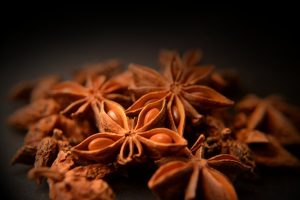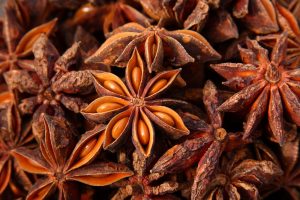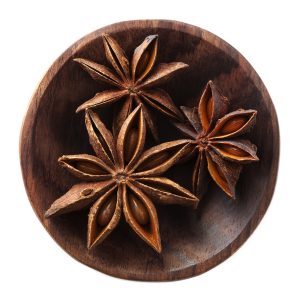Food Blogs
All you need is spice: Star anise
What is Star Anise?
Native to China and Vietnam, star anise is today grown almost exclusively in Southern China, Indo-China, and Japan. Star anise, Illicium verum, is sometimes called Chinese star anise. Star anise is not related to the common anise, Anisum vulgare. It was first introduced into Europe in the seventeenth century. The oil, produced by a process of steam extraction, is substituted for European aniseed in commercial drinks.
What it looks like
Star anise is the unusual fruit of a small oriental tree. It is, as the name suggests, star shaped, radiating between five and ten pointed boat-shaped sections, about eight on average. These hard sections are seed pods. Tough skinned and rust coloured, the fruit is picked before it can ripen, and dried. The stars are available whole, or ground to a red-brown powder.
What it can do for your health
Like anise, star anise has carminative, stomachic, stimulant and diuretic properties. In the East it is used to combat colic and rheumatism. It is a common flavouring for medicinal teas, cough mixtures and pastilles. In traditional Chinese medicine, star anise is prescribed as an digestive aid, promoting health of female reproductive organs and for lactating mothers to increase breast-milk secretion. It is used to promote appetite, to treat abdominal pain, digestive disturbances including colic, complaints caused by cold weather such as lumbago, and to relieve flatulence.The anti-bacterial and anti-fungal properties of star anise are useful in the treatment of asthma, bronchitis and dry cough. For this reason, some cough mixtures contain star anise extract. Star anise, in its natural form, can help the body’s immune system fight off many strains of flu, as well as many other health challenges. Shikimic acid, a compound present in star anise is used for preparing drug for curing influenza or the flu virus. Star anise can also be used as for its sedating properties to ensure a good sleep. The oil of star anise is useful in providing relief from rheumatism and lower back pain. Star anise can also be used as a natural breath freshener.
From the kitchens around the world
Star anise contains anethole, the same ingredient that gives the unrelated anise its flavor. Recently, star anise has come into use in the West as a less expensive substitute for anise in baking as well as in liquor production, most distinctively in the production of the liquor, Galliano. In the West, star anise is added in fruit compotes and jams, and in the manufacture of anise-flavoured liqueurs, the best known being anisette.
It is also used in the production of sambuca, pastis, and many types of absinthe. Star anise enhances the flavour of meat. It is used as a spice in preparation of biryani and masala chai all over the Indian subcontinent. It is widely used in Chinese cuisine, and in Indian cuisine where it is a major component of garam masala, and in Malay and Indonesian cuisines. It is widely grown for commercial use in China, India, and most other countries in Asia. Star anise is an ingredient of the traditional five-spice powder of Chinese cooking. It is also a major ingredient in the making of phở, a Vietnamese noodle soup. Star anise has been used in a tea as a traditional remedy for rheumatism, and the seeds are sometimes chewed after meals to aid digestion.
What it can do for you in your kitchen
Use it to flavour vegetables, meat, and to marinate meat, use it as a condiment for flavouring curries, confectionaries, spirits and for pickling. In Chinese red cooking, where the ingredients are simmered for a lengthy period in dark soy sauce, star anise is nearly always added to beef and chicken dishes. Star anise pairs brilliantly with tomatoes. It’s licorice-like flavor actually bears a close resemblance to that of fennel and basil, tomato’s classic companions. A single pod of star anise adds a new level of flavour to a tomato-based sauce or stew with a warm, spicy undertone. The same goes for braised beef dishes – from stews to chili to oxtail soup, star anise can be the secret ingredient that elevates the dish to a whole new level. Matches well with duck, eggs, fish, leeks, pastry, pears, pork, poultry, pumpkin, shrimp. Use powdered star anise in baking, meat rubs, and bbq sauce to be blown away. Marbled eggs, red cooked beef, braised chicken, sweet tamarind drink- add a little to nail the dish. Use it sparingly–a little goes a long way.
Look out for
It’s important to distinguish it from Japanese star anise, which is highly toxic. Japanese star anise (Illicium anisatum), a similar tree, is highly toxic and inedible; in Japan, it has instead been burned as incense. Cases of illness, including serious neurological effects, such as seizure, were reported after using star anise tea. Japanese star anise contains anisatin, which causes severe inflammation of the kidneys, urinary tract, and digestive organs. The toxicity of the Japanese star anise, also known as shikimi, is caused by its containing potent neurotoxins (anisatin, neoanisatin, and pseudoanisatin), due to their activity as non competitive antagonists of GABA receptors.
Purchasing and storage
Star anise can be purchased whole or ground. The whole spice is quite obtrusive, but can be simmered in sauces, marinades, and soups, then removed before serving. The ground spice is much easier to work with, although the flavor diminishes faster. Whether using the whole or ground spice, store the spice in an air-tight container away from moisture, heat, and sunlight. Whole star anise will remain fresh and vibrantly flavoured for about one year, whereas the ground spice will begin to lose flavour after about six months. Toasting the ground spice sometimes elevates the flavour.
Check out the first ingredient in the series, Hung over hing.



























